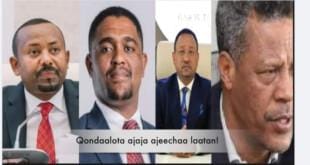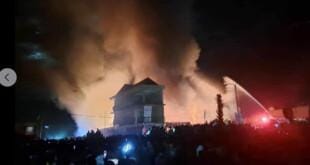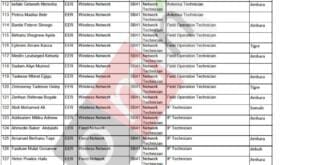Map showing part of the locations where the latest violence is ongoing
Addis Abeba – Residents say dozens of civilians are killed in a renewed violence in Jille Dhummuga district of Oromo Special Zone, in Amhara region, which involved local armed forces and local civilians. Amhara regional state government said this morning that federal police and defense forces have been deployed to the area alongside Amhara special forces to “restore peace and order.”
Several houses are burnt and properties looted and vandalized in the ongoing violence which started on Saturday and has since spread to towns and villages of the neighboring North Shewa Zone including Shewa Robit, as well as Ataye and Jawa towns in Efiratana Gidim district.
In belated statement, released today, the Amhara Regional state government said the violence flared up following an attack perpetrated against members of Amhara special forces and federal police forces stationed in Jawa kebele of Efiratana Gidim district of North Shewa zone on Sunday 21 January at around 3PM by “anti-peace forces” operating in the area. The regional government said that the perpetrators, referred throughout the statement as “anti-peace forces”, also carried out attacks against civilians in both North Shewa and Oromo special zones.
But residents of Senbete town, one of the hardest hit paces located in in Jille Dhummuga district of the Oromo special zone, said local armed forces who are carrying heavy weapons carried out the attacks against civilian populations starting Saturday 20 January.
“They carry DShk [heavy Russian weapon] with which they burnt farmers’ houses and properties in it. They indiscriminately kill civilian. They are carrying out these activities in almost all villages and towns in the district [Jille Dhummuga],” a resident who asked to be anonymous told Addis Standard.
The resident said the attacks which started on Saturday has continued until Tuesday leaving many dead and forcing locals to flee their homes.
“Currently, we’re hiding in the bush. We hoped that government forces would come to rescue us. However, that wasn’t possible. It has been three days now and we have nothing to eat. We couldn’t travel to a safer place as there hasn’t been means of transportation and the security is highly volatile,” the resident said on Tuesday.
He said the attackers are militants of armed group operating in Amhara Region known as Fano. Another resident however said the attackers carry heavy weapons that belong to the regional special force adding that they also travel on vehicles owned by the regional government.
According to the residents almost all who have fled their homes to escape the attack are in dire situation without food and drink for days.
On Monday, the communication department of the Jille Dhummuga district has made a distress call in a Facebook post saying, “currently, Senbete town is in a stressful situation. It requires your prayer. It also demands attention from government or any other stakeholders”.
In contradiction to the residents account, as well as several other reports on local media alleging the involvement of members of members of the Oromo Liberation Army (OLA) however, the statement by the Amhara regional state government blamed “anti-peace forces” without detailing who these forces are, adding that both civilians and members of the regional special forces were killed during the attacks. It also admitted that “there were continued efforts by these anti-peace forces to make the violence look like identity based,” violence.
Administrator of Oromo special zone Ahmed Aliyi told BBC Afaan oromo that violence erupted on Saturday after disagreement between local youth and members of the special forces led to killing of seven Oromo youth by the special forces, which later transpired into clashes between the regional special forces and local residents.
According to Ahmed casualties have not been identified yet but includes civilians and members of the special force. “We haven’t identified the number of people killed yet, but it appears to be higher. Several villages have been burnt,” he told the BBC on Monday.
Shewa Robit, a major town in North Shewa zone has announced curfew disallowing any kind of mobility in the town after 6pm.
Leading Oromo opposition party, Oromo Liberation Front (OLF), has blamed the violence on Amhara regional security forces and irregular militants from Amhara known as Fano, putting the number of civilians killed since Saturday as high as 65.
Civilians in areas bordering the Oromo Special zone and North Shewa zone of the Amhara regional state have endured recurrent violence which saw killing of dozens of civilians, burning down of villages and properties.
Pron to recurring violence
The Oromo Special Zone and the neighboring North Showa Zone of the Amhara regional state is pron to and frequently hit by extreme violence. In July last year, 17 civilians, by local authorities count, were killed, many were also injured and several dozens are displaced and along with severe property damages, including burning of residential quarters.
Two months earlier, in April of same year, Addis Standard reported about a gruesome violence in which dozens of civilians were executed by members of Fano in the area and many more displaced in an area called Kolash which is a border area between Shewa Robit (North Shewa zone) and Wasen Kurkur (Oromo Special zone).
A devastating violence gripped the same area in April 2021 which led to dozens killed and at least 358,000 people displaced. Ataye town, which was the epicenter of the violence, “the entire population was displaced and the town is burned down,” according to a UN report.
A report by the Ethiopian Institution of Ombudsman (EIO) acknowledged failure on the part of the Amhara regional government in managing the recurrent conflicts in the Oromo Special and North Shewa Zones of the region. EIO said that according to its investigations of the violence in April, “303 people were killed, 369 injured, 1,539 houses were torched and based on the information we received from the administrations of the two zones over 50,000 people have been displaced. Provisions of aid is ongoing and is relatively better in North Shewa zone than Oromo Special Zone and yet still the provision in both zones is not satisfactory.” AS




